In today’s post, Anastasia Tsagka, senior BIM Coordinator at CCC and lecturer in Zigurat’s Master’s in Global BIM Management for Infrastrucutre Projects, discusses innovative methods in BIM implementation as put into practice in the construction of City Center Al Zahia Mall project.
Today's presentation is about the BIM implementation Al
Zahia City Center Mall project. This project is one of the biggest retail developments in UAE. It will serve as a trade area for more than 1.9 million people. It was a very demanding construction what made it almost compulsory for the project team to use the highest technology, to be creative and to use innovative BIM methodology tools.
City Center Al Zahia Mall - BIM Implementation project
Location The BIM implementation project is located in the Emirate of Sharjah and aims to attract visitors from Sharjah itself, Dubai, Northern Emirates and the Wider GCC region. For that reason, it is strategically located at the intersection of two main highways: the Sheikh Mohammed Bin Zayed Road and the University City Road. It is also in the close proximity of key landmarks like the Dubai Airport, the Sharjah Airport, Al Zahia community and the university city.
Key Figures The client is the property developer Majid Al Futtaim. The cost of the project is 350 million dollars and the total area is 183,505 square meters.
BIM Implementation Project Description More specifically, we have a three-level mall with a total built-up area of 248,300 square meters and over 400 units of anchor tenants, line shops, flagships, entertainment areas with VOX cinema, a food court area and a Carrefour hypermarket. The mall also counts with a 3-level car park, that can accommodate more than 5200 vehicles, and with its own Energy Center that holds the the primary mechanical plant and equipment and 33 kilovolt station.
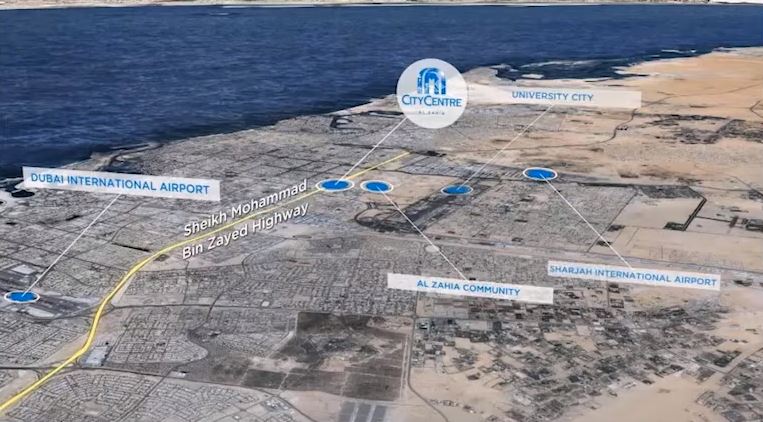
In the video you can observe how the project should look like once it’s finished. In front of the mall there’s a landscape configuration, the car park is connected with the main highways through bridges which guarantees easy access to the mall. Inside the area, you can see the different indoor areas mentioned above.
BIM Workflow and services applied to the City Centre Al-Zahia Mall project
First thing to know here is that the work had to be carried out in three phases: the
contractual phase, the
IFC construction phase and
the construction phase. And the scope must cover all the disciplines: the structural, architectural, mechanical and electrical and the landscape and the civil. In the contractual phase, the team must produce the information models for all the disciplines and keep them up-to-date as per the latest revision packets they have been receiving. They also developed bill of quantity (BOQ) reports and comparison reports, request for information reports For the IFC phase, the team did the design coordination and the clash detection. In the construction phase, they built a 4D construction model for further progress and cost monitoring, they also produced member mark drawings.
What were the biggest challenges of the BIM implementation project? According to Anastasia, one of the biggest challenges in this project was that they had to meet a very tight delivery schedule. But also that the models had to be delivered two months prior to the construction start date, the big volume of work as there was a lot of information to be processed for the digital transformation, etc. These are the main reasons why the project team decided to take advantage of the hands-on experience that CCC has in this field and all the technology they had in their hands.
BIM Deliverables From the very beginning, Anastasia and the team knew that they would be working with Bentley software.
Bentley AECOSIM is a strong authoring solution that’s open and flexible to accommodate the in-house relations of CCC. So they customized their in-house briefings to adapt them to the project needs and created strong digital tools that could guarantee a fast-forward way of work by automating many procedures and the quality of the work. In what follows, we’re gonna see how different IT tools were used in this project.
Authoring: Automation tools
Beams for hollow core slabs. The first problem that they had to solve in the creation of structural models was the creation of beams. They had to create 6.346 beam elements for the shopping mall and 2.034 for the car park. The number was not a problem for CCC, but the time that it would take to go over them all. The majority of the beams were supporting prefabricated hollow core slabs from both sides. So the section had to be transferred to a digital version. Plus, as they were working in a level of detail beyond 3D, they had to create the formwork around the beam. Additionally, for every single beam, they had to go through a set of elements to define the type. Then go to the beam schedule to find the dimensions of the beam and then go to the beam types drawings and decide which section type corresponds to a beam in question depending on the type of hollow core slab that it was supporting from the left and from the right side. And then go to the working file and model the beam in question.
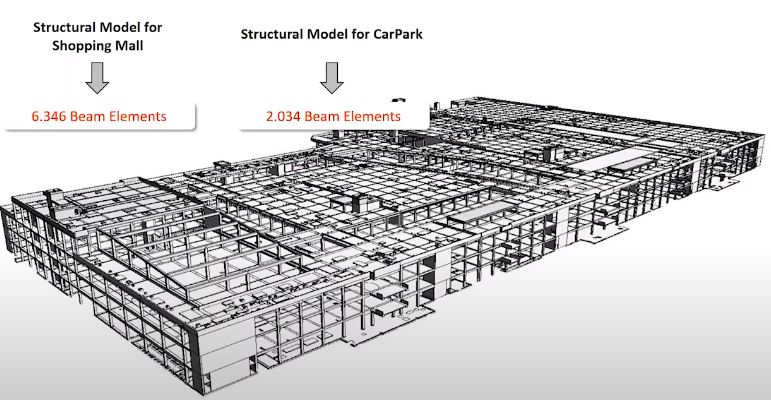
They estimated that this
process was taking five minutes per beam, so they had to find a way to make it more effective. They developed a macro solution that it made it as simple as by five clicks they had the beam created automatically and the time per beam reduced down to 25 seconds. The ROI was 90% here. Doors in the architectural models. Another example where they used automation tools was the creation of the doors. The number of doors to be placed in their architecture was high and the task combined different models, drawings and document types. Every time, they had to be certain that they were working with the most up-to-date drawing and updated revision packages. So once again, they worked with a macro solution that was using information from the plan and it was placing automatically the correct doors at the correct location. Placing a door with a conventional method it would take 1 minute from the team but through automation they got it down to 8 seconds. Using
automation tools permitted the team
to deliver a quality work and reduce the time required for cross-checking documents and human error.
Site Logistics
Anastasia and the team developed 3D crane models and integrated them with the crane schedule and the plan. Then they produced the clash reports which demonstrated the conflicts that they would meet on site and that would affect the construction. Being able to demonstrate this conflict prior to the construction, helped the team avoid many delays on-site, take better decisions and manage their equipment in the most optimum way. Moreover, they used their trustworthy and robust models to create visualization reports for the material verification, to manage design coordination between disciplines, to generate the discrepancy reports and request for information, to extract construction details from the models, to assist in the value engineering studies, and to produce photorealistic images to facilitate the communication with clients and all the project stakeholders.
Scope Management
One of the most important contributions of BIM in this project was for the scope management. They developed BOQs based on CSI coding and comparison reports between the tender BOQ and the IFC models that are reflecting variations from the original scope. You can imagine the impact on the project when you are able to demonstrate this in a scientific way. They also developed summarized and detailed material take-offs per bill of quantity aggregated on their work breakdown structure for the planning and scope of work definition. The
CCC team also developed material take-off reports BOQ per object and then linked with project control system and supported the procurement operations and provided support for the change management.
Project controls
About the material take-off report per BOQ per object, the idea of object-based information models was introduced to be more efficient in construction. We define the object here reasonably as the smallest portion of a building that reflects the logic of construction, facilitates the transfer of work between the different crews and can be reported in progress or QS (quantity surveying) reports. In this case, CCC created a unique coding system for their objects that they call tagging. According to Anastasia, they call in tagging because they assign a tag set to their objects. Tag sets are a listing of specific attributes of objects, like for example, beam ID of our object, its location or the column. A very common tag set that they use is the one that reflects the work breakdown structure of the project. Last but not least, they assign to the objects a unique ID called the member mark. This unique ID is different from the ID that their software automatically generates for their logs. Their difference is that this ID from the software is unique only for the working file where this object belongs to, while the member mark ID is unique for the entire project.
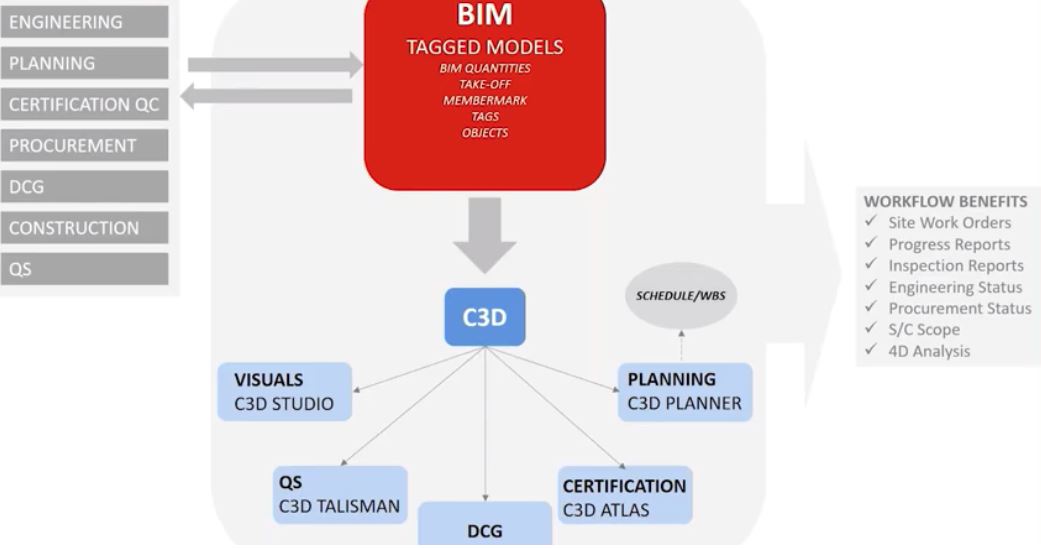
You will understand the importance of this unique ID of the member mark looking at the diagram above. The BIM tagged models are used to send information to different departments: engineering, planning, certification QC, procurement, document control group, construction and quantity surveying. At the same time, the BIM tagged models are feeding their data management platform C3D So, they can keep track of every single object through all the project lifecycle thanks to the member mark. The member mark drawings are integrated with the system for quality control and on-site inspection for which they we use an in-house solution known as the Atlas system. Their tagged models were also integrated in the C3D platform with the planner. So, they were able to visualize the progress of the project and know its status in every phace. The same coding procedure - the tagging - was applied for all the disciplines.
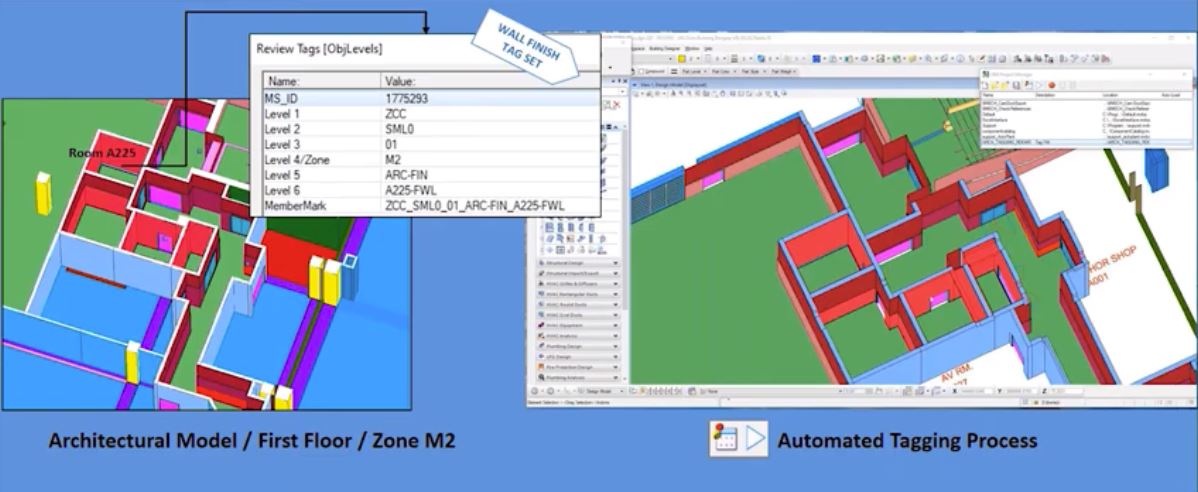
Above is an example for the architectural models where they were tagging the architectural finishes per room. They tagged per room because when extracting the material takeoff, they needed to know in which room number each finish belongs to. Using a macro solution expedites the tagging process a lot.
Conclusion
To wrap up, we have seen how CCC used all their automation tools and BIM methodology for the site logistics, the scope management and the project controls. Anastasia concludes that this project shaped the team to liberate their skills and they followed the path where technology is actively present in the construction optimizing workflows and providing efficiency and quality and leading to successful project delivery.
CCC: who are they and what’s their BIM trajectory? Little introduction to CCC BIM Centers is also in order. At CCC, they have been utilizing BIM workflows for more than 22 years. The first success story was back in 1997 with the Ritz-Carlton hotel in Doha. Back then BIM was hardly known or talked about and CCC realized that they had to take advantage of the computer-aided technology in order to be more efficient in construction. After this success of BIM Implementation story, many projects that were BIM-driven followed. They have received awards recognitions from international organizations for the minipermutation in our projects. Reaching up to today, they have BIM operations backbone which is made up by the centers of excellence in Athens, Cairo and Palestine. The BIM consultancy services where they are working with high-end clients like Siemens and Abu Dhabi National Oil Company. Andthe BIM education with CCC BIM Academy and our partnership with Zigurat Global Institute of Technology. CCC covers a broad portfolio of BIM implementation services, starting from quantity surveying to project control, engineering, facility management, as-built and education. The educational part for us is of high value since right now in the market they are not many specialized BIM engineers. At CCC BIM Academy and the
Master’s in Global BIM Management for Infrastrucutre Projects the instructors believe in a blend of academic and practical outlets from their experience of all these years in this field. CCC targets competent engineers who can meet with BIM technology and deliver successful mega projects.

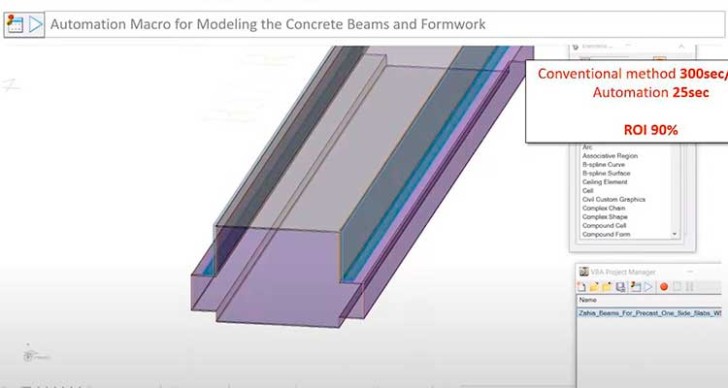
 In the video you can observe how the project should look like once it’s finished. In front of the mall there’s a landscape configuration, the car park is connected with the main highways through bridges which guarantees easy access to the mall. Inside the area, you can see the different indoor areas mentioned above.
In the video you can observe how the project should look like once it’s finished. In front of the mall there’s a landscape configuration, the car park is connected with the main highways through bridges which guarantees easy access to the mall. Inside the area, you can see the different indoor areas mentioned above.
 They estimated that this process was taking five minutes per beam, so they had to find a way to make it more effective. They developed a macro solution that it made it as simple as by five clicks they had the beam created automatically and the time per beam reduced down to 25 seconds. The ROI was 90% here. Doors in the architectural models. Another example where they used automation tools was the creation of the doors. The number of doors to be placed in their architecture was high and the task combined different models, drawings and document types. Every time, they had to be certain that they were working with the most up-to-date drawing and updated revision packages. So once again, they worked with a macro solution that was using information from the plan and it was placing automatically the correct doors at the correct location. Placing a door with a conventional method it would take 1 minute from the team but through automation they got it down to 8 seconds. Using automation tools permitted the team to deliver a quality work and reduce the time required for cross-checking documents and human error.
They estimated that this process was taking five minutes per beam, so they had to find a way to make it more effective. They developed a macro solution that it made it as simple as by five clicks they had the beam created automatically and the time per beam reduced down to 25 seconds. The ROI was 90% here. Doors in the architectural models. Another example where they used automation tools was the creation of the doors. The number of doors to be placed in their architecture was high and the task combined different models, drawings and document types. Every time, they had to be certain that they were working with the most up-to-date drawing and updated revision packages. So once again, they worked with a macro solution that was using information from the plan and it was placing automatically the correct doors at the correct location. Placing a door with a conventional method it would take 1 minute from the team but through automation they got it down to 8 seconds. Using automation tools permitted the team to deliver a quality work and reduce the time required for cross-checking documents and human error.
 You will understand the importance of this unique ID of the member mark looking at the diagram above. The BIM tagged models are used to send information to different departments: engineering, planning, certification QC, procurement, document control group, construction and quantity surveying. At the same time, the BIM tagged models are feeding their data management platform C3D So, they can keep track of every single object through all the project lifecycle thanks to the member mark. The member mark drawings are integrated with the system for quality control and on-site inspection for which they we use an in-house solution known as the Atlas system. Their tagged models were also integrated in the C3D platform with the planner. So, they were able to visualize the progress of the project and know its status in every phace. The same coding procedure - the tagging - was applied for all the disciplines.
You will understand the importance of this unique ID of the member mark looking at the diagram above. The BIM tagged models are used to send information to different departments: engineering, planning, certification QC, procurement, document control group, construction and quantity surveying. At the same time, the BIM tagged models are feeding their data management platform C3D So, they can keep track of every single object through all the project lifecycle thanks to the member mark. The member mark drawings are integrated with the system for quality control and on-site inspection for which they we use an in-house solution known as the Atlas system. Their tagged models were also integrated in the C3D platform with the planner. So, they were able to visualize the progress of the project and know its status in every phace. The same coding procedure - the tagging - was applied for all the disciplines.  Above is an example for the architectural models where they were tagging the architectural finishes per room. They tagged per room because when extracting the material takeoff, they needed to know in which room number each finish belongs to. Using a macro solution expedites the tagging process a lot.
Above is an example for the architectural models where they were tagging the architectural finishes per room. They tagged per room because when extracting the material takeoff, they needed to know in which room number each finish belongs to. Using a macro solution expedites the tagging process a lot.
